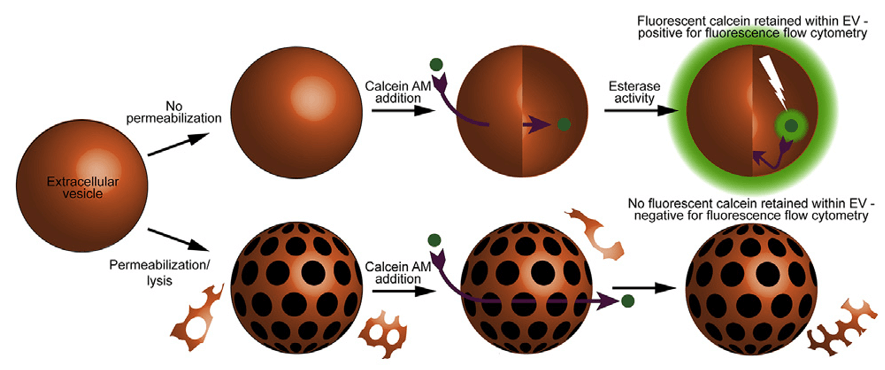Exosome Labeling Services
Overview Services Features FAQs
In the recent years, more and more attention has been paid to investigate the roles of exosomes in therapeutic and diagnostic applications. Exosome labeling is a novel strategy for monitoring exosomes trafficking in vivo, which contributes to optimizing exosome-based diagnosis and treatment. With years of experiences in exosome labeling, Creative Biolabs has developed fluorescent labeling and biotin labeling techniques to track the distribution and movement of the specific exosomes.
Exosome Labeling
Exosomes are small vesicles (30-150 nm in diameter) containing sophisticated RNA and protein cargos and function as a vector of intercellular communication. Up to now, they have been of interest to the scientific community for the roles they play in physiological and pathological processes and their potential for therapeutic and diagnostic applications. In order to further our understandings of exosome characteristics, exosome labeling strategy is raised to investigate the biology and distribution of exosomes, and monitor exosomes trafficking in real time in vivo without invasion. This method is an effective tool for the development and optimization of exosome-based diagnosis and treatment.
 Fig.1 Detection of extracellular vesicles by flow cytometry with calcein AM. (Gray, 2015)
Fig.1 Detection of extracellular vesicles by flow cytometry with calcein AM. (Gray, 2015)
Exosome Labeling Service in Creative Biolabs
The investigation of exosomes biodistribution, as well as their tracking, delivery, and tumor targeting via exosome labeling make it possible to determine their physiological functions and to exploit imaging-derived information for exosome-based theranostics. Here, we offer two technological platforms for exosomes labeling.
-
Exosome Fluorescent Labeling
Antibodies labeled with fluorescent dyes have high affinity with the specific cell-of-origin antigens on the surface of exosomes. And fluorescent dyes can directly label proteins on exosomes. Hence, exosomes labeled with fluorescent dyes can be used to visualize and track specific components in isolated exosomes or to monitor exosome cargo delivery to cells in real-time.
-
Exosome Biotin Labeling
Biotin is a small molecule that forms one of the strongest non-covalent interactions found in nature with its binding partners, avidin, and streptavidin. The high tight non-covalent bond makes labeling proteins with biotin a useful tool for application such as exosome purification and detection. For example, exosomes bearing specific proteins labeled with biotin are used to detect exosome trafficking in vivo or model animal. Importantly, due to its size, biotin rarely disrupts the activity of proteins, making it a good choice for a label.
Advantages and Features of Exosome Labeling Services in Creative Biolabs
-
Specific — our professional scientists have carefully developed exosomes labeling with antibodies or biotin. Based on this method, you can visualize and track exosomes with specific components or drugs in real time.
-
Easy-to-use — labeling protocol is quick and straightforward.
-
High quality service — except for attaining specifically labeled exosome, we also provide comprehensive technical consulting services to resolve your confusion.
Exosome labeling in Creative Biolabs acts as an effective tool for the investigation of exosomes characteristics and exosomes trafficking for the therapeutic and diagnostic application. If you are interested in exosome labeling, please contact us for more information whenever you feel free.
Reference:
-
Gray, W.D.; et al. An accurate, precise method for general labeling of extracellular vesicles. Methodsx. 2015, 2:360-367.
FAQs
What is exosome labeling, and how does it facilitate research?
Exosome labeling involves tagging exosomes with fluorescent dyes or other markers to track their movement, uptake, and interaction with target cells. This labeling enables researchers to visualize and quantify exosome behavior in vitro and in vivo, providing insights into their function and therapeutic potential.
What types of labeling techniques are available for exosomes?
Several labeling techniques exist, including membrane dyes, lipophilic dyes, genetic engineering, and antibody conjugation. Each method offers unique advantages and considerations regarding specificity, stability, and downstream applications, allowing researchers to select the most suitable approach for their experiments.
Can exosome labeling affect their biological properties or function?
While labeling exosomes may alter their physicochemical properties to some extent, careful optimization and validation can minimize any potential impact on their biological behavior. Studies have shown that properly labeled exosomes retain their ability to interact with recipient cells and deliver cargo molecules, preserving their functional integrity.
What types of exosomes can be labeled using your service, and what are the sample requirements?
Our service can label exosomes derived from various sources, including cell culture supernatants, biofluids (such as plasma or urine), and tissue samples. Sample requirements typically include a sufficient exosome yield, purity, and viability for effective labeling and downstream applications.
How can researchers utilize labeled exosomes in their studies, and what experimental applications are supported?
Labeled exosomes can be used for tracking uptake and intracellular trafficking, studying intercellular communication, monitoring exosome biodistribution in vivo, and evaluating therapeutic efficacy. These applications provide valuable insights into exosome biology and facilitate the development of exosome-based diagnostics and therapeutics.
For Research Use Only. Cannot be used by patients.
Related Services:

 Fig.1 Detection of extracellular vesicles by flow cytometry with calcein AM. (Gray, 2015)
Fig.1 Detection of extracellular vesicles by flow cytometry with calcein AM. (Gray, 2015)








